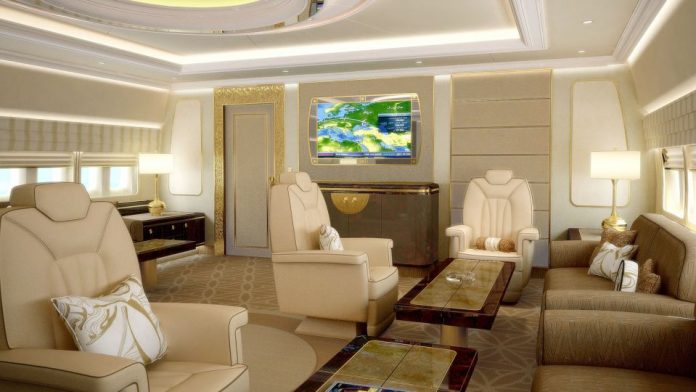A Boeing 747 configured as a private VIP jet is being scrapped after having spent just 30 hours in service over 16 flights. (CNN)
The aircraft, originally intended for a Saudi royal, sat on the ground for almost 10 years at EuroAirport Basel Mulhouse Freiburg, located at the border between France, Switzerland and Germany.
There, it was meant to be fitted with a lavish interior, but that never happened, and after failing to find a new buyer, the plane was eventually flown to Pinal Airpark in Arizona – an aircraft boneyard where retired planes get stripped for parts or stored indefinitely.
Fit for a royal
The plane is a BBJ, for “Boeing Business Jet” – heavily modified editions of Boeing’s jetliners targeted to governments and corporate clients. Its range of over 10,000 miles and cabin space of about 5,000 square feet are unrivaled by any other business aircraft.
It’s also the most advanced model of the Boeing 747 ever produced – the 747-8 variant – which first flew in 2010 but failed to find commercial success due to being expensive to operate. The final one, delivered to cargo operator Atlas Air in early 2023, marked the end of the 747’s production history, though the variant still has a future in the spotlight: two 747-8s are currently being transformed into the next Air Force One planes.
Boeing has sold over 250 BBJs to date, the vast majority of them 737s, which have a broader market appeal. The large, expensive, four-engined BBJ 747-8 was a harder sell: “Ten were built in total, and this is the first one retired,” says Connor Diver, a senior analyst at aviation analytics firm Cirium. “It’s not transparent who exactly is buying them, but it’s a very, very large private aircraft and the only operators or buyers tend to be governments and royal families.”
This particular one was intended for the Saudi Arabian government, and specifically for the Crown Prince Sultan bin Abdulaziz Al-Saud, but he died in 2011, just months before the scheduled delivery. The plane, which was assigned a mandatory registration code – N458BJ – first flew in May 2012 for testing, and was officially delivered in June 2012.
“According to our database, it flew via possibly San Bernardino and then San Antonio in Texas for a couple of months, and then in December of 2012 it went to Basel,” says Diver.
Typically, large business jets are delivered in what’s called a “green” condition – from the color of the protective coating of the fuselage – which means they are empty inside and the interior needs to be installed.
“I’m guessing that’s the reason it went there initially, to be fitted out,” says Diver. “Of course, that never happened. And it looks like it sat there for 10 years.”
No buyers
In 2017, orphaned from its original purpose, the plane went up for sale for $95 million – down from an original list price of around $350 million, according to Diver. It was still empty and advertised as “ready for conversion” in a brochure that can still be found online. But it never sold.
“No one apart from a Saudi head of state is going to want a private, four-engine business jet,” says Richard Aboulafia, an aviation analyst at AeroDynamic Advisory. “You can’t convert just one aircraft to cargo, and nobody wants a passenger version. As a consequence, the parts and especially the engines, are worth far more than the airplane.”
One major hurdle to a sale was the high cost of fitting the interior.
“Fitting one of these out would cost 30, 40 maybe 50 million dollars,” says Diver, “Although you might think it’s a brand new aircraft, the alternate uses for it are rather limited. The commercial passenger variant had a limited production and very few airlines operated it, and they would not be interested in taking any more. So the only other option was potentially another government, but obviously that didn’t happen.”
Boeing, which declined to answer a series of questions about the plane when contacted by CNN, eventually bought it back in 2022, from an aircraft trading company called Aircraft Finance Germany. The plane flew to Arizona on April 15, 2022, adding 10 more hours to its time in the air, representing about a quarter of its total flying time. Its very last takeoff from Basel, was immortalized on YouTube by planespotters.

Scrap value
At Pinal Airpark, a Boeing contractor is still working on disassembling the plane, which has been stripped of the most valuable parts. “I’ve seen pictures of it and it’s been dismantled already, the engines have already been removed,” says Diver. “They were effectively brand new, and one of them is probably in the region of $20 million, so four would be in the region of $80 million.”
Major systems like the auxiliary power unit and some of the environmental control systems would also have been among the first to go, according to Aboulafia.
“Total production of the 747-8 is about 150 aircraft,” he adds. “It’s a small group of users and a small number of aircraft. But on the other hand, they’re going to want to keep those going. I suspect a lot of the components will probably go to the cargo folks.”
It’s unclear whether the plane will be scrapped entirely or put in storage to be harvested for parts later. “What can happen in these cases is that it will sit there until a certain part is needed. They might not necessarily take it all the way down to scrap, and leave it for a few years until somebody wants a specific part,” says Diver.
Nine other BBJ 747s are still being operated by the governments of Egypt, Kuwait, Morocco, Oman, Qatar and Turkey, according to Diver. With the lifespan of a 747 usually clocking in at 25 to 30 years, this one being retired at just 10 years of age is going to set a record that will be difficult to beat.























